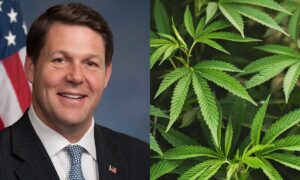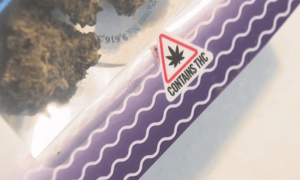
Medical Marijuana Prescription – Photo By NM Political Report
Keeping tabs on the amount of medical cannabis available throughout the state may seem straightforward, but a review of quarterly reports seem to show more cannabis available for sale than what was grown or produced.
While the state’s Department of Health requires producers to accurately track every gram of cannabis—beginning with harvesting and ending with sales—reports from some producers appear to have glaring discrepancies.
Through a review of quarterly reports, NM Political Report found that at least five medical cannabis producers who reported sales exceeding the amount of cannabis that they produced. Those five producers reported selling a combined 676,272 grams of cannabis between January and March, but should have only had a combined 475,028 grams available to sell during that period. This means more than 200,000 grams, or 44 pounds, of medical cannabis sold in New Mexico in three months with almost no accounting of where it came from.
Of the reports that NM Political Report reviewed, the most glaring discrepancy was from Giving Tree Organics in Farmington. According to the reports the company filed, they sold almost 13,000 more grams than they produced, or about 28 pounds.
The number listed online for Giving Tree now goes to a different business and NM Political Report was unable to contact the provider.
Others reporting differences were less drastic.
Grants medical cannabis producer The Harvest Foundation, for example, reported slightly more than 1,000 grams of product on hand at the end of 2016 and reported producing a little more than 64,000 grams of cannabis between January and March. The producer reported selling almost 70,000 grams, leaving 4,461 grams of cannabis unaccounted for.
Opinions differ on why the numbers don’t add up.
Brent Townsley, who said he was in charge of operations at The Harvest Foundation, told NM Political Report there may have been some confusion during their first harvest when they entered the number of grams instead of ounces, but added that he was investigating further.
Paul Rhien, a spokesman for DOH, told NM Political Report some discrepancies “may not necessarily be errors.”
“It’s important to note that these are self-reports,” Rhien wrote in an email. “Each [producer] likely reports information a bit differently.”
Rhien added the Medical Cannabis Program is in the process of standardizing the reporting process for providers to ensure more accuracy. He said he expects the change to take place sometime next year to avoid more reporting problems.
Rhien added that the issue is nuanced and contains “a lot of moving parts.”
Rhien said the Medical Cannabis Program only asks for an in-stock inventory of flower or bud products at the end of each quarter and that cannabis-derived products, like edibles, waxes and oils, are not always considered. Another factor, Rhien said, is producers “may have had plant material being processed into cannabis-derived products, that’s not considered units in stock.”
Erik Briones who runs Minerva, a medical cannabis company, said confusion and a misunderstanding of the required tracking software is most likely the reason Harvest Foundation and others show inaccuracies.
“I attribute that to people not using BioTrack correctly,” Briones said.
BioTrack is the software the state uses to track cannabis in the state from beginning to end. Briones said many producers still have a hard time understanding the specifics of how to use the software. He is also highly critical of the software itself.
“BioTrack is absolutely worthless,” Briones said. “There was no customer support, no training.”
The software was approved through the state’s bidding process under the former and late Secretary of Department of Health Retta Ward, for a contract of about $60,000.
Briones said he doesn’t think the problem is nefariously-minded producers, but instead a failure to educate.
“The reality is, there was no good training on how to use this program,” Briones said.
The consequence of bad data, Briones said, is an inaccurate picture of how much cannabis is being sold and distributed around the state. That inaccurate picture may also be why some say the state is on the verge of a cannabis shortage.
During the 2017 legislative session, state lawmakers tried to increase the limit of plants producers can grow, but Gov. Susana Martinez said she would not sign any legislation increasing plant levels. Martinez said she disagreed that plant level increases should be put into statute and instead recommended changing rules internally through DOH.
The debate over whether the state needs more medical cannabis got more complicated when NM Political Report discovered DOH could not provide records of how much or how often producers sell to each other wholesale.
Article Originally Posted on NM Political Report. Article by Andy Lyman – Original Article




































